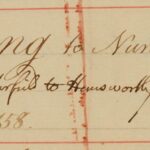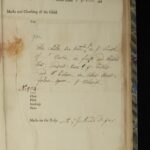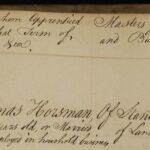Ann Young’s 5x great granddaughters discovered details about her early life in the digitised records of Coram’s Foundling Hospital Archive.
Our search begins
Our only clue to Ann’s unexpected origin was the 1841 census entry for 86-year-old Ann Wildsmith. Ann was living with her youngest child, John, a carpenter, and his family in Worsborough, near Barnsley, in Yorkshire. In the column for ‘Profession, Trade, Employment or of Independent Means’, she is recorded as a London Foundling. The entry was probably intended to relate to the adjacent column which asked whether the person was born in the county; information which could have been relevant for parish relief purposes.
Our initial efforts to learn more about Ann came to nothing because the census and her death certificate in 1848 indicated that she was born in 1755. A couple of visits to the London Metropolitan Archives and help from a Foundling Museum volunteer, who knew which records we needed to check, located an earlier date for her birth. This helped us to uncover her story in Coram’s digitised archive.
Early life
We know that the baby who became Foundling 954 was accepted by the Foundling Hospital on 9 May 1752. A note attached to her billet sheet gives her birth date as 11 April, in the parish of St Martin’s-in-the-Field, London, where she was also baptised. The note states her father’s name as Andrew Burn and that Mrs Watson was the midwife. It contains no information about her mother.
The baptism register of the church of St Martin’s-in-the-Field reveals that Susannah Burne, daughter of Andrew and Eleanor Burne, was baptised there on 26 April 1752. Here, her date of birth is given as 14 April 1752. A marriage record for Susannah’s parents has not been located.
Records in the Foundling Hospital Archive show that Ann Young was given her new name by Miss Cheney and baptised again on 10 May, along with 19 other Foundlings. She was then sent north to a nurse in the Chesterfield area of Derbyshire, where she stayed until June 1755, when she was moved to another nurse in the Hemsworth area of Yorkshire.
There is a possibility that this second nurse lived in Worsborough, which is about nine miles from Hemsworth. Worsborough’s parish registers record the burial of 11 Foundlings between 1756 and 1758; so we know that Foundlings were placed with nurses there.
- Ann Young’s entry in the General Register: A/FH/A/09/002/001/102. Click to enlarge.
- Ann Young’s billet sheet with attached note: A/FH/A/09/001/012/151. Click to enlarge.
Education and apprenticeship
Ann was admitted to the Ackworth branch of the Foundling Hospital in September 1758. She was Ackworth Foundling 76 and lived there for almost six years. She learned to read, but not to write as she marked her marriage register with a cross. She would have been schooled in domestic tasks and also would have assisted in the textile workshop. In June 1764, aged 12, she was apprenticed as a domestic servant to Thomas Horsman of Standish, Lancashire. Yet again, she would have left all that was familiar behind her as she journeyed across the Pennines.
The indenture stated that Ann would remain in Horsman’s employ until her 21st birthday or until she married. The apprenticeship ended early, however, when Thomas died in November 1771, four years after his wife. Ann would have returned to the Ackworth Foundling Hospital. The digitised archive does not record if she was found another position, but this is likely.
- Ann Young’s entry in the Apprenticeship Register: A/FH/A/12/003/001/063. Click to enlarge.
Marriage and family
In February 1777, 25-year-old Ann married Timothy Wildsmith, a 20-year-old farmer whose family could trace its ancestry back well over a century in Worsborough.
In the 16th century, the Wildsmiths appear relatively prosperous, with substantial lands in south Yorkshire. In the 17th century, the men of the family seem to have worked in collaboration in the complementary businesses of farming, running an abattoir and carpentry.
By the time Ann and Timothy married, the family had slipped down the social scale as the land and other ventures appear to have been split amongst earlier generations. Timothy was a farmer, probably with a regular income, but with limited land. Ann was a busy working wife. Between 1777 and 1799, she gave birth to six sons and five daughters, nine of whom lived to adulthood. In the early years of her marriage, she probably had to look after her widowed mother-in-law and her husband’s fatherless younger siblings as well as her own family.
For Ann and Timothy’s sons, moving away from farming was a practical necessity as the land Timothy worked would have been too small to provide for them all as adults. Baptism records for Ann’s grandchildren show that by the 1820s, four of her sons were earning their living in other local occupations, such as weaving, bleaching and coal mining. The son who remained on the land seems to have been employed rather than working on his own account.
Timothy died in 1821, and it is likely that Ann moved out of their home to live with one of her sons. Her youngest son, John, seems to have done better for himself than his brothers. He had a recognised trade as a carpenter, was well-respected as the parish clerk, and was probably the best placed to provide her with a home. She was living with his family in 1841 and also when she died on 3 January 1848 aged 95, of ‘decay of nature’, having outlived five of her 11 children. Two days later she was buried at St Mary’s Church, Worsborough, alongside Timothy.
Parish records indicate that Ann and Timothy had at least 63 grandchildren. Our own knowledge is limited to a few of the many descendants of just two of these grandchildren. A 2x great grandson settled in Pennsylvania, USA, in 1895. In the 20th century, other descendants spread out across England. Two of Ann’s 3x great granddaughters and one 4x great granddaughter have celebrated their hundredth birthdays.
It is an amazing legacy for a baby whose own survival depended on the vision of Thomas Coram and the generosity and hard work of his supporters.
Bibliography
Foundling Hospital Archive
General Register: A/FH/A/09/002/001/102
Billet: A/FH/A/09/001/012/151
Baptism Register: A/FH/A/14/004/001/071
Inspection Book: A/FH/A/10/004/001/165
Ackworth Foundling Hospital Register: A/FH/Q/01/064/033
Apprenticeship Register: A/FH/A/12/003/001/063




